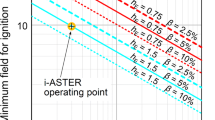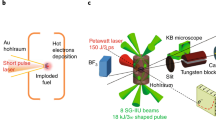Summary
The Ignitor experiment was the first proposed and designed on the basis of existing technologies in order to study the conditions where the charged fusion reaction products of a deuterium-tritium, magnetically confined plasma can deposit their energy in the plasma and compensate for all its forms of thermal-energy loss. The proposal of this experiment was made possible by the discovery, through the Alcator line of experiments, of a relevant law governing the confinement of the plasma thermal energy. The Alcator experiments are characterized by high-plasma-density regimes, high magnetic fields and compact dimensions. A set of criteria to compare the potential performance of existing and future experiments is discussed. The long-range evolution of the Alcator-Ignitor line of experiments is pointed out and shown to open the possibility to verify the fusion burn condition of deuterium-deuterium or deuterium-helium 3 (the so-called clean fusion) plasma mixtures. In fact, the present design parameters of Ignitor allow for the confinement of the charged particle products of all these reactions.
Riassunto
Ignitor è il primo esperimento ad essere proposto e progettato sulla base di tecnologie esistenti per studiare le condizioni in cui, in un plasma di deuterio-trizio confinato magneticamente, le particelle cariche prodotte dalle reazioni di fusione depositano nel plasma la loro energia compensando in questo modo tutte le possibili perdite. L'ideazione di questo esperimento è stata resa possibile dalla scoperta, ottenuta con gli esperimenti Alcator, di una importante legge che è alla base delle proprietà di confinamento dell'energia termica in un plasma. Gli esperimenti Alcator sono caratterizzati da regimi di plasma di elevata densità, da forti campi magnetici e strutture e dimensioni compatte. In questo articolo si esaminano anche alcuni criteri atti a paragonare le potenzialità e le prestazioni di esperimenti presenti e futuri. Si indica inoltre come lo sviluppo a lungo termine della linea Alcator-Ignitor permetta di verificare le condizioni di accensione termonucleare di un plasma composto da deuterio-deuterio o da deuterio-elio 3 (il combustibile cioè della cosiddetta fusione pulita). In effetti i parametri di progettazione attuali di Ignitor sono piú che sufficienti per ottenere il confinamento delle particelle cariche prodotte da entrambe queste reazioni di fusione.
Резюме
Эксперимент «Игнитор» был предложен и спланирован на основе существующей технологии, чтобы исследовать условия, при которых заряженные продукты реакции синтеза в магнитно удерживаемой длазме дейтерия и трития могут выделять свою энергию в плазме и компенсировать все формы тепловых энергетических потерь. Предложение этого эксперимента стало возможным благодаря открытию соответствующего эакона, определяющего удержание тепловой энергии в плазме, в экспериментах на Алкаторе. Эксперименты на Алкаторе характеризуются высокой плотностью плазмы, высокими магнитными полями и компактными размерами. Обсуждается система критериев для сравнения потенциального вьшолнения настоящих и будущих экспериментов. Отмечается долгосрочная эволюция экспериментов на линии «Алкатор-Игнитор». Показывается, что открывается возможность проверки условий синтеза в плазменных смесях дейтерия и дейтерия или дейтерия и гелия-три (так называемый чистый синтез). Действительно, предполагаемые параметры Игнитора допускают удержание заряженных частиц-продуктов всех зтих реакций.
Similar content being viewed by others
References
B. Coppi: Massachusetts Institute of Technology, R.L.E. Report PRR-75/18 (Cambridge, MA, August 1975) andComments Plasma Phys. Controlled Fusion,3, 2 (1977). Presented at the Special Session on Tokamak Ignition Experiments, 1976 I.A.E.A. Conference, Berchtesgaden, Germany, reprinted inA Perspective of Physics, Vol.2, edited byR. Peierls (Gordon and Breach, London, 1978), p. 225.
B. Coppi:Phys. Scr., T2/2, 590 (1982).
R. J. Hawryluuk and the TFTRGroup: Paper I.A.E.A. CN-47/1-I-3 inPlasma Physics and Controlled Nuclear Fusion Research 1986, (I.A.E.A., Vienna, 1986) (Proceedings of the I.A.E.A. Conference, Kyoto, Japan, 1986).
B. Coppi, F. Pegoraro, G. Lampis, L. Pieroni andS. Segre: Massachusetts Institute of Technology, R.L.E. Report PRR-75/4 (Cambridge, MA, 1975).
N. Niedermeyer, F. Wagner, the ASDEX, NI-, ICRH- and Pellet-Teams: inPlasma Physics and Controlled Nuclear Fusion Research 1986, Paper I.A.E.A. CN-47/A-II-5 (I.A.E.A., Vienna, 1987).
B. Coppi: Massachusetts Institute of Technology, R.L.E. Report PTP-86/18 (Cambridge, MA, October 1986).
B. Coppi andL. Sugiyama:Comments Plasma Phys. Controlled Fusion,10, 43 (1986).
B. Coppi andF. Porcelli:Phys. Rev. Lett. 57, 2272 (1986).
Author information
Authors and Affiliations
Rights and permissions
About this article
Cite this article
Coppi, B., Pegorado, F. Salient characteristics of the Ignitor experiment. Il Nuovo Cimento D 9, 691–701 (1987). https://doi.org/10.1007/BF02457029
Received:
Issue Date:
DOI: https://doi.org/10.1007/BF02457029




